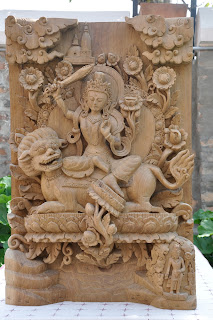Bandini fabric drying in the sun.
Janis joplin in a tie and dye outfit at woodstock.
A bandini saree.
In 1967,
Michael McClure led the crowd chanting “OM” at the San Francisco’s
Golden Gate and started off the “hippie” movement. A movement that pursued the
realization of individuality based on the fundamental ethos of being in harmony
with nature. A time when power had become all pervasive and there was no
ideology left, the youth decided to get back to the core value system that
humanity stands for-peace, love and harmony. Never was the Indian connection so
strong, hippies grew their hair long, wore psychedelic colorful clothes and
conformed to eastern philosophy. Artistic experimentation especially in music
was huge but perhaps the most prominent remnant of that generation is their Organically ‘tie and dyed’ colorful
clothes.
Now, in western India women have been using organic methods
to make their clothes colorful since ancient times. Bandini or bandhej is an
art of 'tie and dye’ practiced mainly in the
states of Rajasthan and Gujarat. By using simple techniques of dyeing fabrics
like cotton and muslin that are tied tightly with a thread, various patterns
like Lehriya, Mothda, Ekdali and Shikari are created. Each village has its own
unique pattern of dots and stripes made in pink, green, yellow, red by their
women in the backyards of their homes.
As I mentioned in my previous blog a visit to Gujarat got me
the opportunity to witness women living in a village near Rajkot make bandini fabric. Pools of
colored water had fabric soaked in it. Vegetable dyes were being used to keep
the process earthy and organic. Unlike the West where tie and dye was used to uphold an ideology on what
life ought to be (a gentle nondoctrinaire ideology of peace, love and
personal freedom), here in this village that ideology was a way of life.
Human beings living peacefully in harmony with nature, sustaining themselves
with an ancient art form that enabled their women financial and personal freedom.
As I stood there, I remembered college days where I would wear psychedelic tees
and flaunt an ideology that I didn’t truly grasp till now. Being a hippie
didn’t just mean a hedonistic lifestyle, it was about free expression and essentially
a striving for realization of one’s relationship to life and other people.
These rural women around me had no idea about the profound impression their
simple bandini had made in my mind. They lived a life in communal harmony where
basic food clothing and shelter mattered and had no complications of modern
life. Promoting their work would give me a sense a pride since I would be
adding a tie and dye art form made in India to Kriya Kalash thus allowing me to
be steeped in my roots but branching it out all over the place…
If you would like bandini (tie and dye) fabric from India, kindly contact us on kriyakalash@gmail.com






